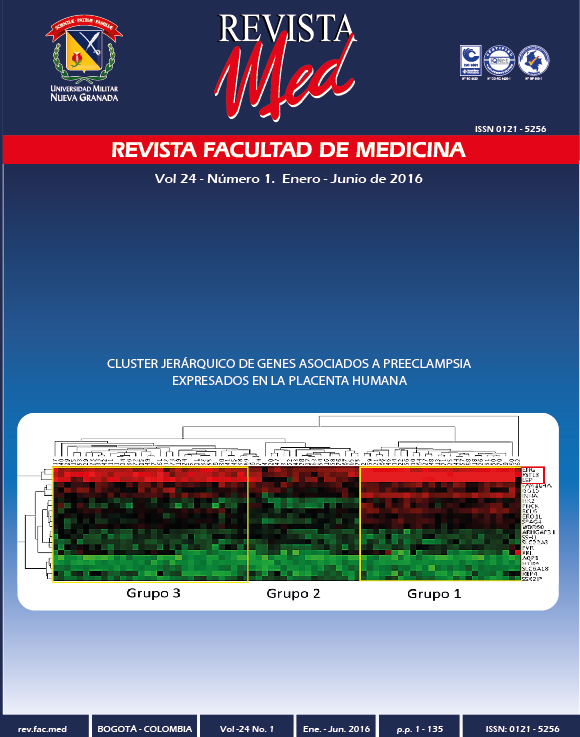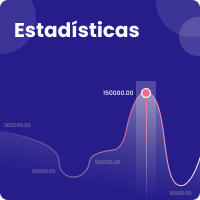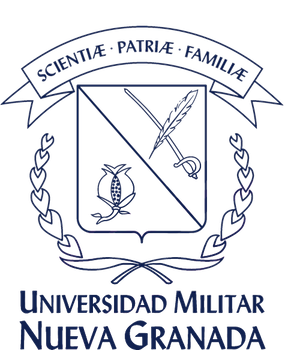Trasplante autólogo “potenciado”, de células madre CD34+ de médula ósea, en pacientes con angina refractaria. Estudio piloto
Resumen
Objetivo: Evaluar la eficacia a 6 meses del trasplante autólogo de células madre CD34+ de médula ósea “potenciado”, mediante pre-condicionamiento isquémico en pacientes con angina refractaria.
Métodos: Estudio piloto con 14 pacientes con angina refractaria, clase funcional clínica mayor o igual a III (NYHA y CCS), del Servicio de Cardiología del Hospital Militar Central. Fueron seleccionados por conveniencia 14 pacientes los cuales se asignaron aleatoriamente a 2 grupos, el primero (intervención) con trasplante autólogo de células madre CD34+ de médula ósea potenciado mediante pre-condicionamiento isquémico por vía intravenosa más tratamiento médico convencional, y el segundo (control) con tratamiento médico convencional. Se realizaron mediciones basales a 6 meses del umbral de angina/isquemia medido en mets y clase funcional.
Resultados: Al comparar las medianas, el cambio en el valor umbral de angina/isquemia 6 meses después, para el grupo intervenido fue de 3.5 mets vs 0.9 mets, para el grupo control P= 0.013. No se registraron complicaciones inherentes al tratamiento.
Conclusiones: En esta investigación, los pacientes con angina refractaria intervenidos con trasplante autólogo de células madre de médula ósea CD34+ potenciado mediante precondicionamiento isquémico mostraron mejoría del umbral de angina y clase funcional a 6 meses.
Descargas
Lenguajes:
esAgencias de apoyo:
Hospital Militar CentralReferencias bibliográficas
Bernstein SJ, Brorsson B, Aberg T, Emanuelsson H, Brook RH, Werkö L. Appropriateness of referral of coronary angiography patients in Sweden. SECOR/SBU Project Group. Heart. 1999; 81:470–477. http://dx.doi.org/10.1136/hrt.81.5.470
Povsic TJ, Broderick S, Anstrom KJ, Shaw LK, Ohman EM, Eisenstein EL, et al. Predictors of long-term clinical endpoints in patients with refractory angina. J Am Heart Assoc. 2015; 4:e001287. http://dx.doi.org/10.1161/JAHA.114.001287
Hemingway H, Crook AM, Feder G, Banerjee S, Dawson JR, Magee P, et al. Underuse of coronary revascularization procedures in patients considered appropriate candidates for revascularization. N Engl J Med. 2001; 344:645-54. http://dx.doi.org/10.1056/NEJM200103013440906
Serruys PW, Andrew T.L, Lex A. Herwerden, J. Sousa E, Jatene A, et al. Five-Year Outcomes After Coronary Stenting Versus Bypass Surgery for the Treatment of Multivessel Disease. The Final Analysis of the Arterial Revascularization Therapies Study (ARTS) Randomized Trial, J Am Coll Cardiol. 2005; 46(4):575-581. http://dx.doi.org/10.1016/j.jacc.2004.12.082
Fihn SD, Gardin JM, Abrams J, Berra K, Blankenship JC, Dallas AP, et al. ACCF/AHA/ACP/AATS/PCNA/SCAI/STS Guideline for the Diagnosis and Management of Patients With Stable Ischemic Heart Disease: A Report of the American College of Cardiology Foundation/American Heart Association Task Force on Practice Guidelines, and the American College of Physicians, American Association for Thoracic Surgery, Preventive Cardiovascular Nurses Association, Society for Cardiovascular Angiography and Interventions, and Society of Thoracic Surgeons. Journal of the American College of Cardiology. 2012; 60(24): e44-e164. http://dx.doi.org/10.1016/j.jacc.2012.07.013
Montalescot G, Sechtem U, Achenbach S, Andreotti F, Arden C, Budaj A, et al. Guía de práctica clínica de la ESC 2013 sobre diagnóstico y tratamiento de la cardiopatía isquémica estable. Rev Esp. Cardiol. 2014; 67(2):135.e1-e81. http://dx.doi.org/10.1016/j.recesp.2013.11.007
Bernstein SJ, Brorsson B, Aberg T, Emanuelsson H, Brook RH, Werkö L. Appropriateness of referral of coronary angiography patients in Sweden. SECOR/SBU Project Group. Heart. 1999; 81:470–477. http://dx.doi.org/10.1136/hrt.81.5.470
Mukherjee D, Bhatt DL, Roe MT, Patel V, Ellis SG. Direct myocardial revascularization and angiogenesis—how many patients might be eligible?. Am J Cardiol. 1999; 84:598-600. http://dx.doi.org/10.1016/S0002-9149(99)00387-2
Henry TD, Satran D, Hodges JS, Johnson RK, Poulose AK, Campbell AR, et al. Long-term survival in patients with refractory angina. Eur Heart J. 2013;34:2683–2688. http://dx.doi.org/10.1093/eurheartj/eht165
Mukherjee D, Comella K, Bhatt DL, Roe MT, Patel V, Ellis SG . Clinical outcome of a cohort of patients eligible for therapeutic angiogenesis or transmyocardial revascularization. Am Heart J. 2001; 142:72-74. http://dx.doi.org/10.1067/mhj.2001.115786
Kandzari DE, Lam LC, Eisenstein EL, Clapp‐hanning N, Fine JT, Califf RM, et al. Advanced coronary artery disease: appropriate end points for trials of novel therapies. Am Heart J. 2001; 142:843-851. http://dx.doi.org/10.1067/mhj.2001.119136
Loh PH, Cleland JGF, Louis AA, Kennard ED, Cook JF, Caplin JL, et al. Enhanced external counterpulsation in the treatment of chronic refractory angina: a long-term follow-up outcome from the international enhanced external counterpulsation patient registry. Clin Cardiol. 2008; 31:159-164. http://dx.doi.org/10.1002/clc.20117
Mohr FW, Morice MC, Kappetein AP, Feldman TE, Ståhle E, Colombo A, et al. Coronary artery bypass graft surgery versus percutaneous coronary intervention in patients with three-vessel disease and left main coronary disease: 5-year follow-up of the randomised, clinical SYNTAX trial. Lancet. 2013; 381:629-638. http://dx.doi.org/10.1016/S0140-6736(13)60141-5
Losordo DW, Henry TD, Davidson C, Sup Lee J, Costa MA, Bass T, et al. ACT34-CMI Investigators. Intramyocardial, autologous CD34+ cell therapy for refractory angina. Circ Res. 2011; 5; 109(4):428-36.
Asahara T, Murohara T, Sullivan A, Silver M, van der Zee R, Li T, et al. Isolation of putative progenitor endothelial cells for angiogenesis. Science. 1997; 275:964 –967. http://dx.doi.org/10.1126/science.275.5302.964
Menasché P, Hagege AA, Scorsin M, Pouzet B, Desnos M, Dubo D, et al: Myoblast transplantation for heart failure. Lancet. 2001, 357: 279 – 280. http://dx.doi.org/10.1016/S0140-6736(00)03617-5
Kawamoto A, Iwasaki H, Kusano K, Murayama T, Oyamada A, Silver M, et al. Cd34-positive cells exhibit increased potency and safety for therapeutic neovascularization after myocardial infarction compared with total mononuclear cells. Circulation. 2006; 114:2163–2169. http://dx.doi.org/10.1161/CIRCULATIONAHA.106.644518
Iwasaki H, Kawamoto A, Ishikawa M, Oyamada A, Nakamori S, Nishimura H, et al. Dose-dependent contribution of cd34-positive cell transplantation to concurrent vasculogenesis and cardiomyogenesis for functional regenerative recovery after myocardial infarction. Circulation. 2006; 113:1311–1325. http://dx.doi.org/10.1161/CIRCULATIONAHA.105.541268
Zeng L, Hu Q, Wang X, Mansoor A, Lee J, Feygin J, et al, Bioenergetic and Functional Consequences of Bone Marrow–Derived Multipotent Progenitor Cell Transplantation in Hearts With Postinfarction Left Ventricular Remodeling, Circulation. 2007; 115: 1866-1875. http://dx.doi.org/10.1161/CIRCULATIONAHA.106.659730
Pokushalov E, Romanov A, Chernyavsky A, Larionov P, Terekhov I, Artyomenko S, et al. Efficiency of intramyocardial injections of autologous bone marrow mononuclear cells in patients with ischemic heart failure: a randomized study. J Cardio vasc Transl Res. 2010; 3: 160–168. http://dx.doi.org/10.1007/s12265-009-9123-8
Perin EC, Silva GV, Henry TD, Cabreira-Hansen MG, Moore WH, Coulter SA, et al. A randomized study of transendocardial injection of autologous bone marrow mononuclear cells and cell function analysis in ischemic heart failure (FOCUS-HF). Am Heart J. 2011; 161: 1078–1087. http://dx.doi.org/10.1016/j.ahj.2011.01.028
Van Ramshorst J, Bax JJ, Beeres SL, Dibbets-Schneider P, Roes SD, Stokkel MP, et al. Intramyocardial bone marrow cell injection for chronic myocardial ischemia: a randomized controlled trial. JAMA. 2009; 301: 1997–2004. http://dx.doi.org/10.1001/jama.2009.685
Wang S, Cui J, Peng W, Lu M: Intracoronary autologous CD34+ stem cell therapy for intractable angina. Cardiology. 2010; 117: 140–147. http://dx.doi.org/10.1159/000320217
Losordo DW, Schatz RA, White CJ, Udelson JE, Veereshwarayya V, Durgin M, et al. Intramyocardial transplantation of autologous cd34_ stem cells for intractable angina: a phase i/iia double-blind, randomized controlled trial. Circulation. 2007; 115:3165–3172. http://dx.doi.org/10.1161/CIRCULATIONAHA.106.687376
Kovacic JC1, Macdonald P, Feneley MP, Muller DW, Freund J, Dodds A, et al. Safety and efficacy of consecutive cycles of granulocyte-colony stimulating factor, and an intracoronary CD133+cell infusion in patients with chronic refractory ischemic heart disease: The G-CSF in Angina patients with IHD to stimulate Neovascularization (GAIN I) trial, AHJ November 2008Volume 156, Issue 5, Pages 954–963
Tse HF, Thambar S, Kwong YL, Rowlings P, Bellamy G, McCrohon J, et al. Prospective randomized trial of direct endomyocardial implantation of bone marrow cells for treatment of severe coronary artery diseases (PROTECT-CAD trial). Eur Heart J 2007, 28:2998-3005. http://dx.doi.org/10.1093/eurheartj/ehm485
Li N, Yang YJ, Zhang Q, Jin C, Wang H, Qian HY, et al. Stem cell therapy is a promising tool for refractory angina: a meta-analysis of randomized controlled trials. Can J Cardiol. 2013; 29:908–914. http://dx.doi.org/10.1016/j.cjca.2012.12.003
Fisher SA, Dorée C, Brunskill SJ, Mathur A, Martin-Rendon E. Bone marrow stem cell treatment for ischemic heart disease in patients with no option of revascularization: a systematic review and meta-analysis. PLoS One. 2013; 8:e64669. http://dx.doi.org/10.1371/journal.pone.0064669
Povsic J, Junge C, Nada A, Schatz RA, Harrington RA, Davidson CJ, et al. RENEW. A phase 3, randomized, double-blinded, active-controlled, unblinded standard of care study assessing the efficacy and safety of intramyocardial autologous CD34+ cell administration in patients with refractory angina: Design of the RENEW study Thomas, Am Heart J. 2013;165:854-861.e2. http://dx.doi.org/10.1016/j.ahj.2013.03.003
Jiménez-Quevedo P, González-Ferrer J, Sabate M, García-Moll X, Delgado-Bolton R, Llorente L, et al. Promote Angiogenesis in Patients with Refractory Angina Final Results of the PROGENITOR Randomized TrialCirc Res. 2014; 115:950-960.
Iwasaki H1, Kawamoto A, Ishikawa M, Oyamada A, Nakamori S, Nishimura H et al. Dose-Dependent Contribution of CD34-Positive Cell Transplantation to Concurrent Vasculogenesis and Cardiomyogenesis for Functional Regenerative Recovery After Myocardial Infarction, Circulation. 2006; 113: 1311-1325 http://dx.doi.org/10.1161/CIRCULATIONAHA.105.541268
Leri A, Anversa P. Stem Cells and Myocardial Regeneration Cooperation Wins Over Competition, Circulation. 2013; 127: 165-168. http://dx.doi.org/10.1161/CIRCULATIONAHA.112.153973
Freyman T1, Polin G, Osman H, Crary J, Lu M, Cheng L, et al, A quantitative, randomized study evaluating three methods of mesenchymal stem cell delivery following myocardial infarction, European Heart Journal. 2006; 27(9): 1114 - 1122
Fischer UM1, Harting MT, Jimenez F, Monzon-Posadas WO, Xue H, Savitz SI, et al. Pulmonary Passage is a Major Obstacle for Intravenous Stem Cell Delivery: The Pulmonary First-Pass Effect, Stem Cells Dev. 2009 Jun; 18(5): 683–691. Stem Cells Dev. 2009; 18(5): 683–691.
Hou D1, Youssef EA, Brinton TJ, Zhang P, Rogers P, Price ET, et al. Radiolabeled Cell Distribution after Intramyocardial, Intracoronary, and Retrograde Venous Delivery: CMN, Circulation. 2005; 112(Suppl I):I150-I156.
Aicher A1, Brenner W, Zuhayra M, Badorff C, Massoudi S, Assmus B, et al . Assessment of the tissue distribution of transplanted human endothelial progenitor cells by radioactive labeling. Circulation. 2003; 107:2134-9. http://dx.doi.org/10.1161/01.CIR.0000062649.63838.C9
Blocklet D1, Toungouz M, Berkenboom G, Lambermont M, Unger P, Preumont N, et al . Myocardial homing of nonmobilized peripheral-blood CD34+ Cells after intracoronary injection. Stem Cells. 2006; 24:333-6. http://dx.doi.org/10.1634/stemcells.2005-0201
Hofmann M, Wollert KC, Meyer GP, et al. Monitoring of Bone Marrow Cell Homing Into the Infarcted Human Myocardium. Circulation. 2005; 111:2198-2202. http://dx.doi.org/10.1161/01.CIR.0000163546.27639.AA
Malliaras K, Zhang Y, Seinfeld J, Galang G, Tseliou E, Cheng K, et al. Cardiomyocyte proliferation and progenitor cell recruitment underlie therapeutic regeneration after myocardial infarction in the adult mouse heart. EMBO Mol Med. 2013; 5: 191 – 209. http://dx.doi.org/10.1002/emmm.201201737
Ghadge SK, Muhlstedt S, Ozcelik C, Bader M. SDF-1alpha as a therapeutic stem cell homing factor in myocardial infarction. Pharmacol Therapeut. 2011; 129:97-108. http://dx.doi.org/10.1016/j.pharmthera.2010.09.011
Strauer BE1, Brehm M, Schannwell CM. The therapeutic potential of stem cells in heart disease, Cell Prolif. 2008; 41 (Suppl. 1), 126–145.
Adams V1, Lenk K, Linke A, Lenz D, Erbs S, Sandri M, et al. Increase of Circulating Endothelial Progenitor Cells in Patients with Coronary Artery Disease After Exercise-Induced Ischemia. Arteriosclerosis, Thrombosis, and Vascular Biology. 2004; 24: 684-90. http://dx.doi.org/10.1161/01.ATV.0000124104.23702.a0
World Medical Association. World Medical Association Declaration of Helsinki Ethical Principles for Medical Research Involving Human Subjects. JAMA. 2013; 310(20): 2191-2194. http://dx.doi.org/10.1001/jama.2013.281053
Mannheimer C, Camici P, Chester MR, Collins A, DeJongste M, Eliasson T, et al. The problem of chronic refractory angina; report from the ESC Joint Study Group on the Treatment of Refractory Angina. Eur Heart J. 2002; 23:355-70. http://dx.doi.org/10.1053/euhj.2001.2706
.The Criteria Committee of the New York Heart Association. Nomenclature and Criteria for Diagnosis of Diseases of the Heart and Great Vessels. 9th ed. Boston, Mass: Little, Brown & Co. 1994; 253-256.
Campeau L: Canadian Cardiovascular Society Functional classification of angina pectoris [letter]. Circulation. 1976; 54:522.
Kavita Sharma, Priya Kohli, Martha Gulati, FACC, FAHA, An Update on Exercise Stress Testing, Curr Probl Cardiol. 2012; 37:177-202. http://dx.doi.org/10.1016/j.cpcardiol.2011.11.004
Pellikka PA1, Nagueh SF, Elhendy AA, Kuehl CA, Sawada SG; American Society of Echocardiography, American Society of Echocardiography Recommendations for Performance, Interpretation, and Application of Stress Echocardiography. Journal of the American Society. 2007; 20(9): 1021-1041.
Gibbons RJ, Balady GJ, Bricker JT, Chaitman BR, Fletcher GF, Froelicher VF, et al. American College of Cardiology/American Heart Association Task Force on Practice Guidelines. Committee to Update the 1997 Exercise Testing Guidelines. ACC/AHA 2002 guideline update for exercise testing: summary article. A report of the American College of Cardiology/American Heart Association Task Force on Practice Guidelines (Committee to Update the 1997 Exercise Testing Guidelines). J Am Coll Cardiol. 2002; 16;40(8):1531-40.
Fletcher GF, Balady GJ, Amsterdam EA, Chaitman B, Eckel R, Fleg J, et al. Exercise Standards for Testing and Training A Statement for Healthcare Professionals From the American Heart Association. Circulation. 2001; 104:1694-1740. http://dx.doi.org/10.1161/hc3901.095960
Blanco-Guarín MI, Avila-Portillo LM, Arango A, Avila J, Vásquez JP, Álvarez O, et al. Medición en diferentes periodos de tiempo de factores asociados a anidación de células madre, en pacientes con falla cardiaca y angina refractaria, posterior a estimulación cardiaca controlada. Revista Med. 2013;21 (suplemento 1): S22.
Demko SG.Transplantation procedures. En:Burt RK, Deeg HJ, Santos GW (eds.).On call in Bone marrow Transplantation.Chapman and Hall, New York, 1996; pág.: 39-51.
Confer DL, Stroncek DF.Bone Marrow and peripheral blood stem cell donors. En: Thomas ED, Blume KG, Forman SJ (eds.).Hematopoietic cell transplantation. Blackwell Scientific Inc. Malden,1999;421-30.
Hibino N, Nalbandian A, Devine L, Martinez RS, et al. Comparison of human bone marrow mononuclear cell isolation methods for creating tissue-engineered vascular grafts: novel filter system versus traditional density centrifugation method. Tissue Engineering Part C Methods. 2011;17(10):993-8 http://dx.doi.org/10.1089/ten.tec.2011.0110
Pranke P., Hendrikx J., Alespeiti4 G., Nardi N., Rubinstein P. et al. Comparative quantification of umbilical cord blood CD34+ and CD34+ bright cells using the ProCount™-BD and ISHAGE protocols. Brazilian Journal of medical and Biological Research. 2006; 39: 901-906 http://dx.doi.org/10.1590/S0100-879X2006000700008
AHA/AACVPR Scientific Statement. Core Components of Cardiac Rehabilitation/Secondary Prevention Programs 2007 Update. Balady G. et al. Circulation. 2007; 115:2675-2682.
American Association of Cardiovascular and Pulmonary Rehabilitation: Guidelines for Cardiac Rehabilitation and Secondary Prevention Programs, Fourth Edition, Human Kinetics, 2004.
E. Halkos, Z. Q. Zhao, F. Kerendi et al., "Intravenous infusion of mesenchymal stem cells enhances regional perfusion and improves ventricular function in a porcine model of myocardial infarction,"Basic Research in Cardiology, vol. 103, no. 6, pp. 525–536, 2008. http://dx.doi.org/10.1007/s00395-008-0741-0
Noritosi Nagaya, Takafumi Fujii, Takashi Iwase, Hajime Ohgushi, Takefumi Itoh et al, Intravenous administration of mesenchymal stem cells improves cardiac function in rats with acute myocardial infarction through angiogenesis and miogénesis, American Journal of Physiology - Heart and Circulatory Physiology, Published online before print July 29, 2004, 1152.
J.M. Hare, J. H. Traverse, T. D. Henry et al., "A randomized, double-blind, placebo-controlled, dose-escalation study of intravenous adult human mesenchymal stem cells (prochymal) after acute myocardial infarction," Journal of the American College of Cardiology, vol. 54, no. 24, pp. 2277–2286, 2009. http://dx.doi.org/10.1016/j.jacc.2009.06.055
Calvin C Sheng, Li Zhou, an Jijun Hao, Current Stem Delivery Methods for Myocardial repair, BioMed Research international vol 2013, Article ID547902, 1-15.







.png)





